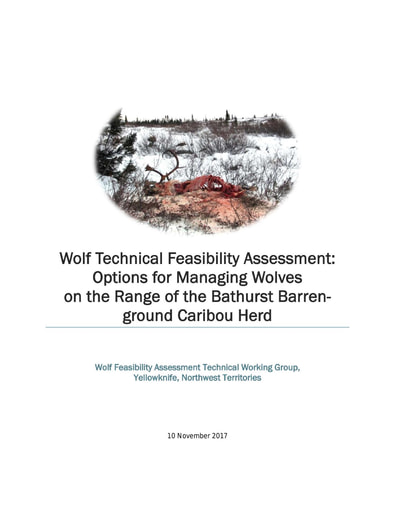pdf 17-11-10 WRRB-Technical Working Group - Wolf Feasibility Assessment Popular
By Catarina Owen 9667 downloads
17-11-10 WRRB-Technical Working Group - Wolf Feasibility Assessment.pdf

This report titled Wolf Technical Feasibility Assessment: Options for Managing Wolves on the Range of the Bathurst Barren-ground Caribou Herd was finalized on November 10, 2017, by the Wolf Feasibility Assessment Technical Working Group. The Wolf Feasibility Assessment Technical Working Group (WG) was formed to compile information about wolf management options and their risks. These options are to be provided to management authorities, who in turn, and depending on their decisions, will submit specific management proposals for review in a public forum to allow for further discussion. The WG examined options for reducing wolf predation through lethal and non-lethal removal of wolves. Each option was reviewed under four criteria: humaneness, cost efficiency, likely effectiveness, and risks and uncertainties. The main text of this document was kept relatively brief with details provided in appendices. The WG applied detailed criteria to assess the humaneness and welfare of each option as well as examining the relative cost, while acknowledging that more details will be required for specific proposals. Risks include the limited information about wolf numbers and predation rates, and overlapping distribution of Bathurst caribou with neighbouring herds in recent winters. The overlap may locally increase caribou and wolves, but, in spring, the herds separate and return to their calving and summer ranges, and the wolves typically return to their dens on the herd’s summer range. The Wolf Feasibility Assessment Technical Working Group (WG) was formed to compile information about wolf management options and their risks. These options are to be provided to management authorities, who in turn, and depending on their decisions, will submit specific management proposals for review in a public forum to allow for further discussion. The WG examined options for reducing wolf predation through lethal and non-lethal removal of wolves. Each option was reviewed under four criteria: humaneness, cost efficiency, likely effectiveness, and risks and uncertainties. The main text of this document was kept relatively brief with details provided in appendices. The WG applied detailed criteria to assess the humaneness and welfare of each option as well as examining the relative cost, while acknowledging that more details will be required for specific proposals. Risks include the limited information about wolf numbers and predation rates, and overlapping distribution of Bathurst caribou with neighbouring herds in recent winters. The overlap may locally increase caribou and wolves, but, in spring, the herds separate and return to their calving and summer ranges, and the wolves typically return to their dens on the herd’s summer range.Through evaluation of technical opinions and computer modelling, the WG found that removing about 124 wolves in the first year and maintaining low wolf numbers for 5 years, gives the highest likelihood of halting the Bathurst herd’s decline and starting it toward recovery. Although the options are evaluated individually, combinations of options may have an increased probability of success.


 Phone: 867-374-4040
Phone: 867-374-4040 Email:
Email: